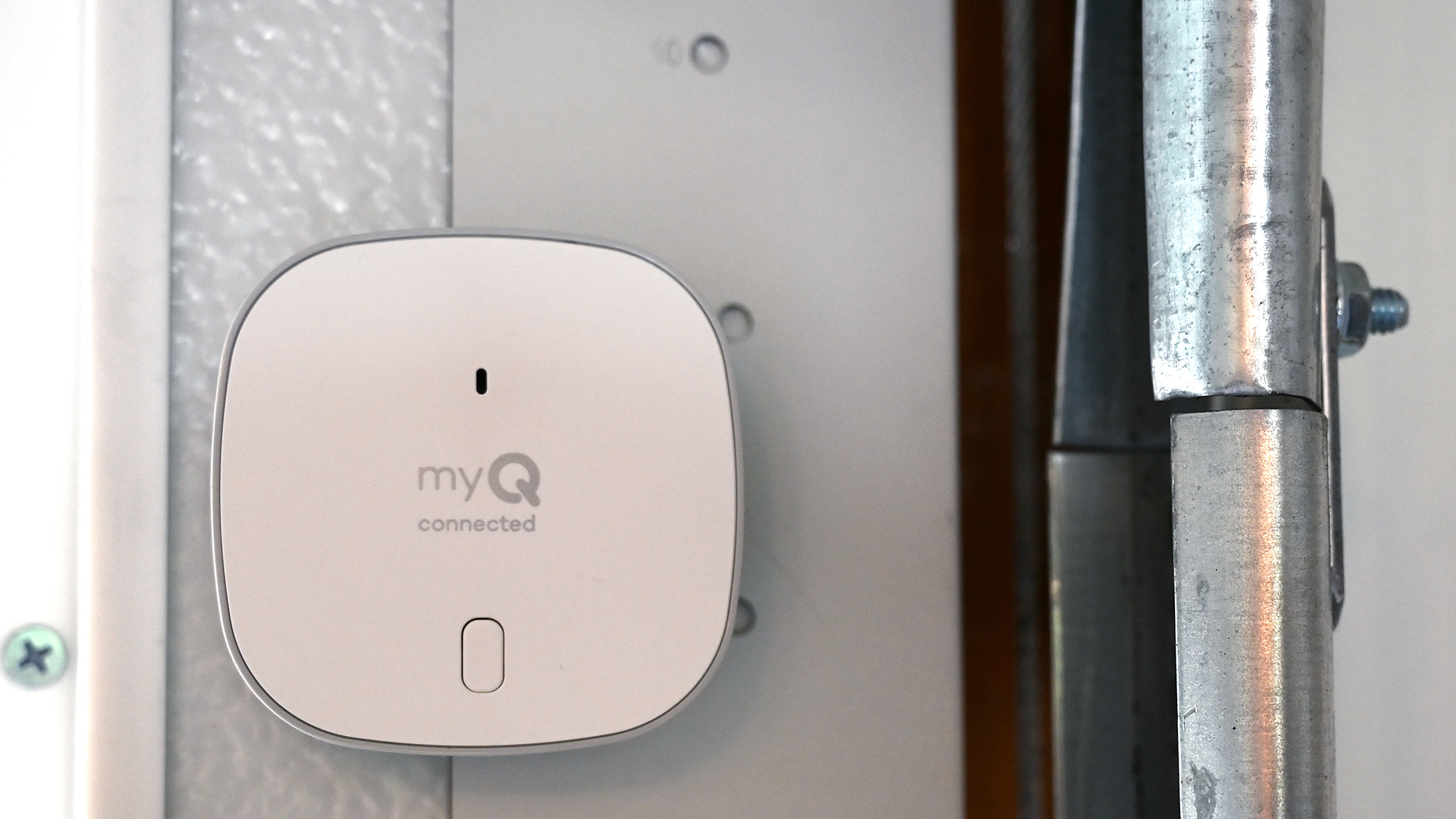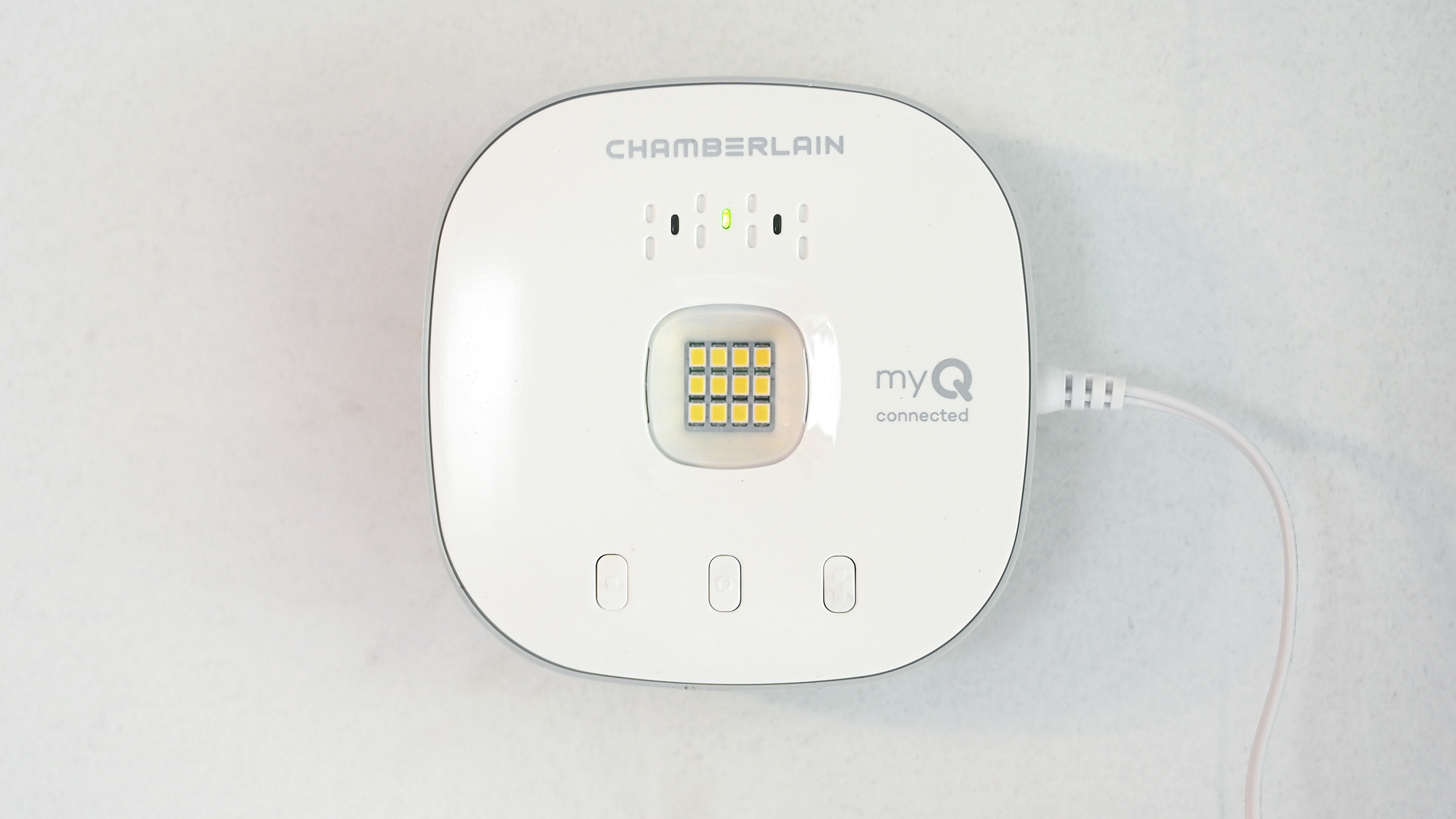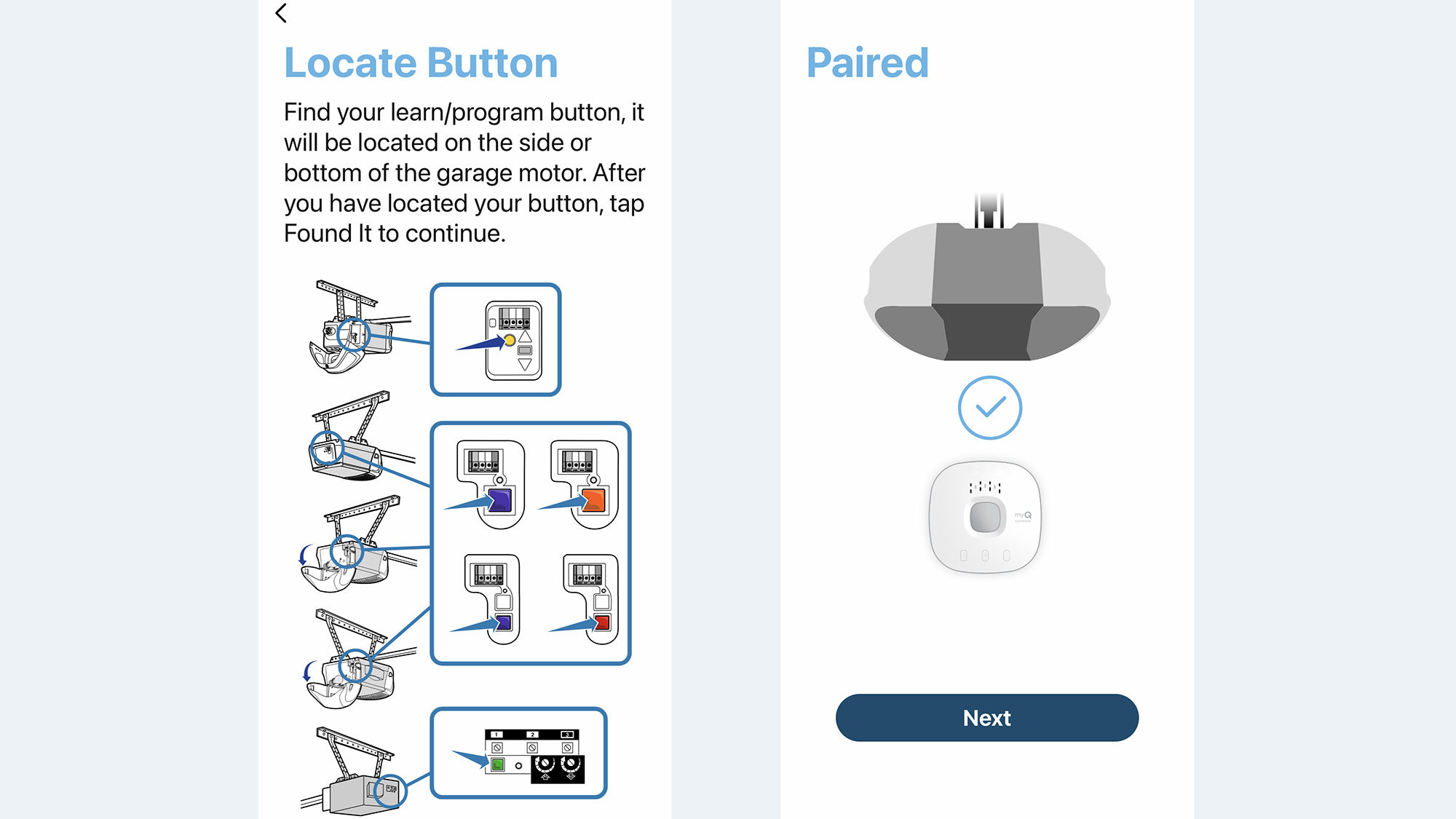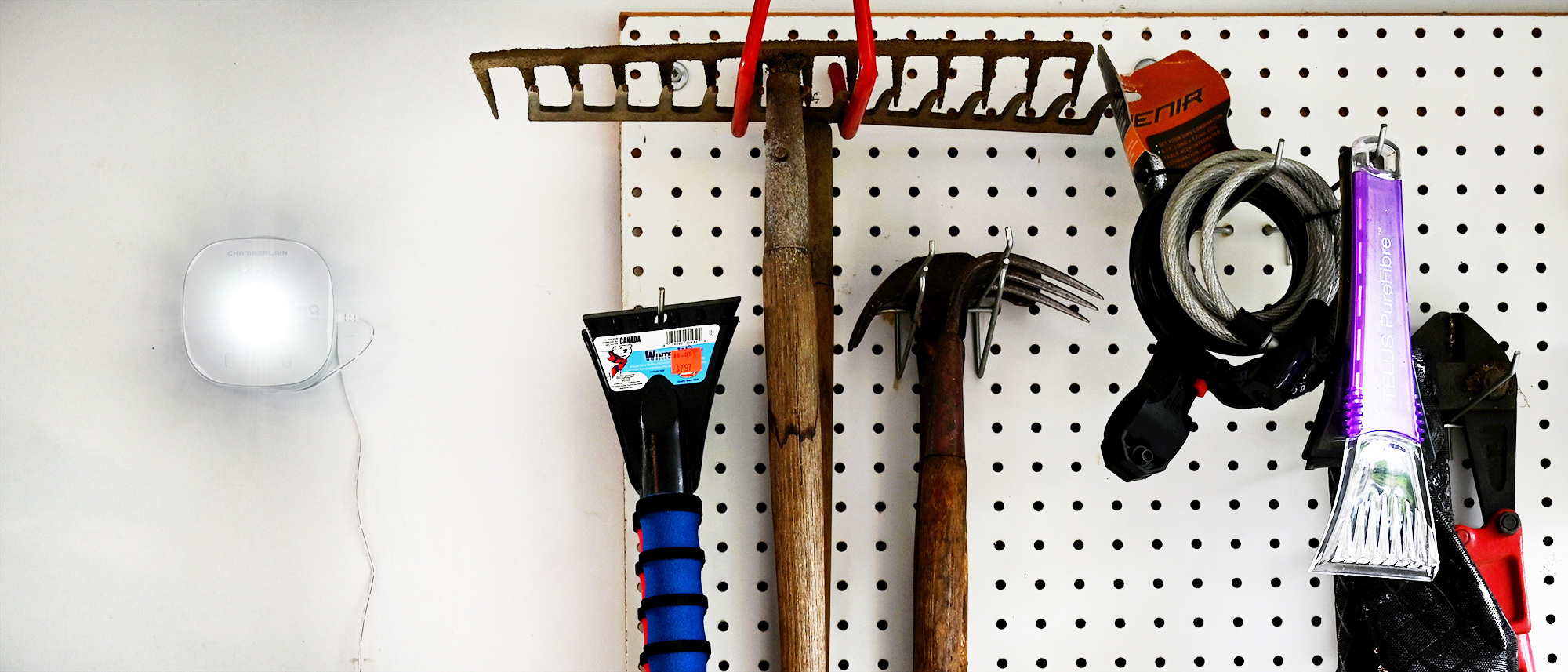Tom's Guide Verdict
The Chamberlain myQ is an inexpensive smart garage door opener that's extremely easy to install and use. However, it lacks support for Amazon Alexa.
Pros
- +
Quick setup and easy to use
- +
Well-designed mobile app (iOS and Android)
- +
Clear, easy to understand directions for set up and help
- +
Works with Amazon Key
Cons
- -
Doesn't work with Amazon Alexa
- -
Two-factor authentication not on by default
Why you can trust Tom's Guide
Compatibility: Android, iOS
Wireless: Wi-Fi (2.4GHz), Bluetooth
Works with: Google Assistant, IFTTT, Vivint Smart Home, XFINITY Home, Alpine Audio Connect, Eve for Tesla, Resideo Total Connect and Key by Amazon
Lacks support for: Amazon Alexa
Not only is the Chamberlain myQ Smart Garage door opener (MYQ-G0401-E) relatively inexpensive for a smart garage door opener, but it’s extremely easy to install and to use, too.
Among the best smart garage door openers, the myQ remains our top pick for its intuitiveness and compatibility with a wide range of smart home systems. However, it doesn’t have two-factor authentication tuned on my default, and though it works with Amazon Key (and many other smart home systems), it still lacks support for Amazon Alexa.
Chamberlain myQ Smart Garage Control: Price and availability
The Chamberlain Smart Garage Control is listed on the myQ.com website for $39.98, but we’ve seen it as low as $29.98 on Amazon; on Prime Day, it even dropped to $17. That’s one of the cheapest smart garage door openers we’ve seen, aside from the Genie Aladdin Connect, which costs $28.19.
Chamberlain myQ Smart Garage Control: Installation and design
In order to install and use this version of the Chamberlain Smart Garage Control, your residential door opener should have been manufactured after 1993 and use photoelectric sensors located near the bottom of the door. The manual also says you should not use this with a one-piece or swinging garage door.

When you open the box, you’ll find the Chamberlain Smart Garage Control model comes with two square pieces of hardware (along with a few smaller items): a large wireless hub and a smaller door sensor.

Both are primarily white and have a clean design. The door sensor has just one red LED and one test button on it. The large hub has three LEDs, a warning light (which flashes on and off before closing the garage door) and three buttons — a settings button and two buttons to activate two different garage doors. (This system lets you install two different sensors for two different garage doors: you can use the same hub, but you’ll need a second door sensor, which costs extra.) In the account settings, you can also add additional items to the system, such as a security camera, but that’s not included with this kit and will cost extra.

The hub is powered by a power adapter, which you’ll need to be plug into a power outlet. The door sensor runs on a battery.
I was very impressed with how easy it was to install this product. It only took about 15 or 20 minutes, and I was able to start opening and closing the garage door right from my iPhone 12, the phone I used to test this product.

To begin, just download the app (available for Android and iOS), and then follow along with the step-by-step directions. What made the process so easy is the clear language used in the directions and the easy-to-understand diagrams and animated GIFs, showing you everything from how to find the “Learn” button on your garage door opener to where to position the sensor on your garage door. It even included a link to a YouTube video right in the directions.
Chamberlain myQ Smart Garage Control: App and performance
Like the directions, I found the myQ mobile app’s language, organization and design very useful. After downloading the app, I needed to set up a myQ account, which I was able to do directly from my phone by filling out some basic information. The instructions, app and the system itself (the hub and door sensor) do require a decent Wi-Fi signal from your home wireless connection (using a 2.4GHz signal). Since my garage is pretty close to my wireless router, this garage door system had a strong signal. However, there have been some user reviews that have complained about problems with Wi-Fi signals using this product.

As I mentioned earlier, I was impressed at how quickly I was up and running. And once it was set up, I could easily open and close the door from my phone. However, it’s not quite as integrated with home technologies (since it lacks Alexa support) as other models.
Chamberlain myQ Smart Garage Control: Security and smart home compatibility
One of the first steps in setting up the myQ mobile app on your smartphone is that it will require that you set up an account. After you set it up, you’re sent a verification email, which requires that you click on a link in the email.

However, the myQ app does not have two-factor authentication on by default. In the security section of the app, there is a section for setting up a passcode, which could make the system more secure, but the setup did not require this.
This system works with quite a number of different smart-home technologies, including Google Assistant, IFTTT, Vivint Smart Home, XFINITY Home, Alpine Audio Connect, Eve for Tesla, and Resideo Total Connect. However, as noted earlier, it’s still not compatible with Amazon Alexa.

But it does work with Amazon Key, which lets delivery people leave packages inside your garage, to lessen the chance they’ll get stolen. The service is free for Amazon Prime members, and you’ll need authorized shippers to have access to your garage or your car truck in order to successfully make those deliveries to you. But it can give you peace of mind if you’re often away from your home and fear that your deliveries might be stolen.
Chamberlain myQ Smart Garage Control: Verdict
I found that both the Chamberlain Smart Garage Control hardware (the hub and the sensor) as well as installing the mobile apps was one of the most pleasant experiences I’ve had in working with technology, particularly the wide array of smart wireless devices I’ve worked with over the past 16 or so years. Overall, I was very impressed with how the device’s manual presented all the information, from setup to functionality.
However, although it works with many smart assistants, like Google Assistant and IFTTT, it still doesn’t have support for Alexa. We also wish that it had two-factor authentication on by default. But when it comes to convenience and cost, the Chamberlain myQ can’t be beat.
Terry Sullivan is an experienced technology journalist who has covered consumer electronics including cameras, smartphones, audio tech and software among many other things. His work has appeared in the likes of Consumer Reports, PCMag, Lifehacker, and the New York Times and he is also a teacher, photographer, artist, and musician.
-
Jim Edwards You didn't mention that integrating Chamberlain myQ to smart home services such as IFTTT & Google assistant require you to create a Myq account and while currently free will charge a subscription fee of approx. $12/year. A con when you consider others are free.Reply -
Chamberlain Hi Jim, in order to use the myQ service you are correct that you need to create a myQ account which is standard practice for any smart home service. Our myQ app and core features through it are free. At the moment there is no plan to end the free offer for linking partners like Google Assistant and IFTTT. In the event that the offer ends customers will be given a 30 day notice. Users do not have to provide their credit card at sign up and will not be prompted for a credit card at any point during the continuation of the offer.Reply -
JustGreg Reply
I have had the previous version of the MyQ hub and with garage door sensors which provided sensing and control for my two legacy (not wifi) liftmaster garage door controllers. I could separately monitor and control each of my two garage doors. The system worked fine for about a year - until it didn't. A couple of days ago, I received some unknown error about a sensor (I wish i'd have taken a shapshot) on my phone - with a message to press the button on my sensor. I did - and the whole system went south. One of my garage doors was gone from the menu. I now found out how BADLY the software has been architected.admin said:The Chamberlain myQ is an inexpensive, intuitive, and easy-to-use smart garage door opener. However, it doesn’t work with Amazon Alexa.
Chamberlain myQ (G0401) Smart Garage Door Opener review : Read more
Because of the way the app is written (iphone), I couldn't just remove the devices and re-install them - because my devices aren't available to select in the app as separate devices. The only way that the devices were visible is through the INITIAL setup routine. SO I I had to reset EVERTYTHING and start from scratch (reset the hub, add a sensor, link with garage door opener, add another sensor, add another controller. And I had to step through ALL OF THE instructions on how to mount the devices over and over again. What a pain. The software writers took the easy way out - at my expense. But that wasn't all.
Finally, when everything was done, BOTN of my door openers respond SIULTANEOUSLY to ONE door's commands. It appears that there is insufficient logic in the app or system or software to deal with the fact that my openers already had been linked to the MyQ. The software ended up linking each door to a COMMON signal. I am now going to have to totally reset both of my garage door openers, program my remotes, and then program myQ. I am hopeful that after a couple more hours of hassle, it may all work again. Lazy programmers = a lot of wasted time if you ever have to change something. -
rgd1101 Reply
did you send this to Chamberlain ?JustGreg said:I have had the previous version of the MyQ hub and with garage door sensors which provided sensing and control for my two legacy (not wifi) liftmaster garage door controllers. I could separately monitor and control each of my two garage doors. The system worked fine for about a year - until it didn't. A couple of days ago, I received some unknown error about a sensor (I wish i'd have taken a shapshot) on my phone - with a message to press the button on my sensor. I did - and the whole system went south. One of my garage doors was gone from the menu. I now found out how BADLY the software has been architected.
Because of the way the app is written (iphone), I couldn't just remove the devices and re-install them - because my devices aren't available to select in the app as separate devices. The only way that the devices were visible is through the INITIAL setup routine. SO I I had to reset EVERTYTHING and start from scratch (reset the hub, add a sensor, link with garage door opener, add another sensor, add another controller. And I had to step through ALL OF THE instructions on how to mount the devices over and over again. What a pain. The software writers took the easy way out - at my expense. But that wasn't all.
Finally, when everything was done, BOTN of my door openers respond SIULTANEOUSLY to ONE door's commands. It appears that there is insufficient logic in the app or system or software to deal with the fact that my openers already had been linked to the MyQ. The software ended up linking each door to a COMMON signal. I am now going to have to totally reset both of my garage door openers, program my remotes, and then program myQ. I am hopeful that after a couple more hours of hassle, it may all work again. Lazy programmers = a lot of wasted time if you ever have to change something.

